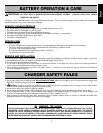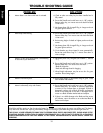
8
ENGLISH
BLADE SHARPENING
KEEP BLADE SHARP FOR BEST MOWER PERFORMANCE. A DULL BLADE DOES NOT CUT GRASS CLEANLY OR MULCH PROPERLY.
WEAR PROPER EYE PROTECTION WHILE REMOVING, SHARPENING, AND INSTALLING BLADE. ENSURE THAT SAFETY KEY IS REMOVED.
Sharpening the blade twice during a mowing season is usually sufficient under normal circumstances. Sand causes the blade to dull quickly. If
your lawn has sandy soil, more frequent sharpening may be required.
REPLACE BENT OR DAMAGED BLADE IMMEDIATELY.
WHEN SHARPENING THE BLADE:
1. Make sure blade remains balanced.
2. Sharpen blade at the original cutting angle.
3. Sharpen cutting edges on both ends of blade, removing equal amounts of material from both ends.
TO SHARPEN BLADE IN A VISE:
1. Be sure the switch lever is released, the blade has stopped and the safety key removed before removing the blade.
2. Remove blade from mower. See instructions for removing and attaching blade.
3. Secure blade M-1 in a vise M-2.
4. Wear safety glasses and be careful not to cut yourself.
5. Carefully file the cutting edges of the blade with a fine tooth file M-3 or sharpening stone.
6. Check balance of blade. See instructions for blade balancing.
7. Replace blade on mower and tighten securely. Refer to instructions below.
BLADE BALANCING
Check balance of blade by placing centre hole in blade N-1 over a nail or screwdriver shank N-2, clamped horizontally in a vise N-3. If either
end of the blade rotates downward, file that end. Blade is properly balanced when neither end drops.
REMOVING AND ATTACHING BLADES
1. TURN MOWER OFF, WAIT FOR THE BLADE TO STOP, AND REMOVE SAFETY KEY.
2. Cut a piece of 2x4 wood P-1 (about 2 feet long) to keep blade from turning while removing blade nut.
3. Turn the mower on its side. Wear gloves. Position wood and remove nut as shown in Figure P.
4. With 3/4” (19mm) wrench P-2, remove blade nut P-3, by turning in direction of arrow.
5. Remove blade nut Q-1, square washer Q-2, insulator washer Q-3, and blade Q-4.
6. To re-assemble, first position the blade with the cutting edges towards the ground. (“Grass side” is stamped on the blade and should be
visible when assembled correctly.) Assemble the components as shown in Figure Q.
Ensure that the edges of the insulator washer Q-3 hook over the edge of the blade. Align the flats on the insulator washer Q-3 with the flats
on the shaft.
Position wood R-1 to keep shaft from turning and then securely tighten the blade nut in the direction shown by the arrow in Figure R.
LUBRICATION
No lubrication is necessary. Do not oil the wheels. They have plastic bearing surfaces which require no lubrication.
CLEANING
TURN OFF, LET THE BLADE COME TO A STOP AND THEN UNPLUG SAFETY KEY. Use only mild soap and a damp cloth to clean the mower.
Clean out any clippings which may have accumulated on the underside of the deck. After several uses, check all exposed fasteners for tightness.
PREVENTING CORROSION
Fertilizers and other garden chemicals contain agents which greatly accelerate the corrosion of metals. If you mow in areas where fertilizers or
chemicals have been used, the mower should be cleaned immediately afterward as follows: (1) Be sure the mower is turned off and safety key
removed. (2) Wipe all exposed parts with a damp cloth.
CAUTION: DO NOT POUR OR SPRAY WATER ON THE MOWER IN AN ATTEMPT TO CLEAN IT.
Do not store the tool on or adjacent to fertilizers or chemicals. Such storage can cause rapid corrosion.
TRANSPORTING AND STORAGE
WARNING: Rotating blade can cause serious injury. Always turn mower off and remove the safety key before lifting, transporting
or storing the mower. Store in a dry place. Based on seasonally consistent cutting schedules your mower will cut up to 19,000 square feet on a
single charge. During the spring when the grass is lush it may cut less. During mid-summer when the grass is light and dry it will cut more. Then
in the fall when the grass is wetter it may cut less.
ENGLISH


















